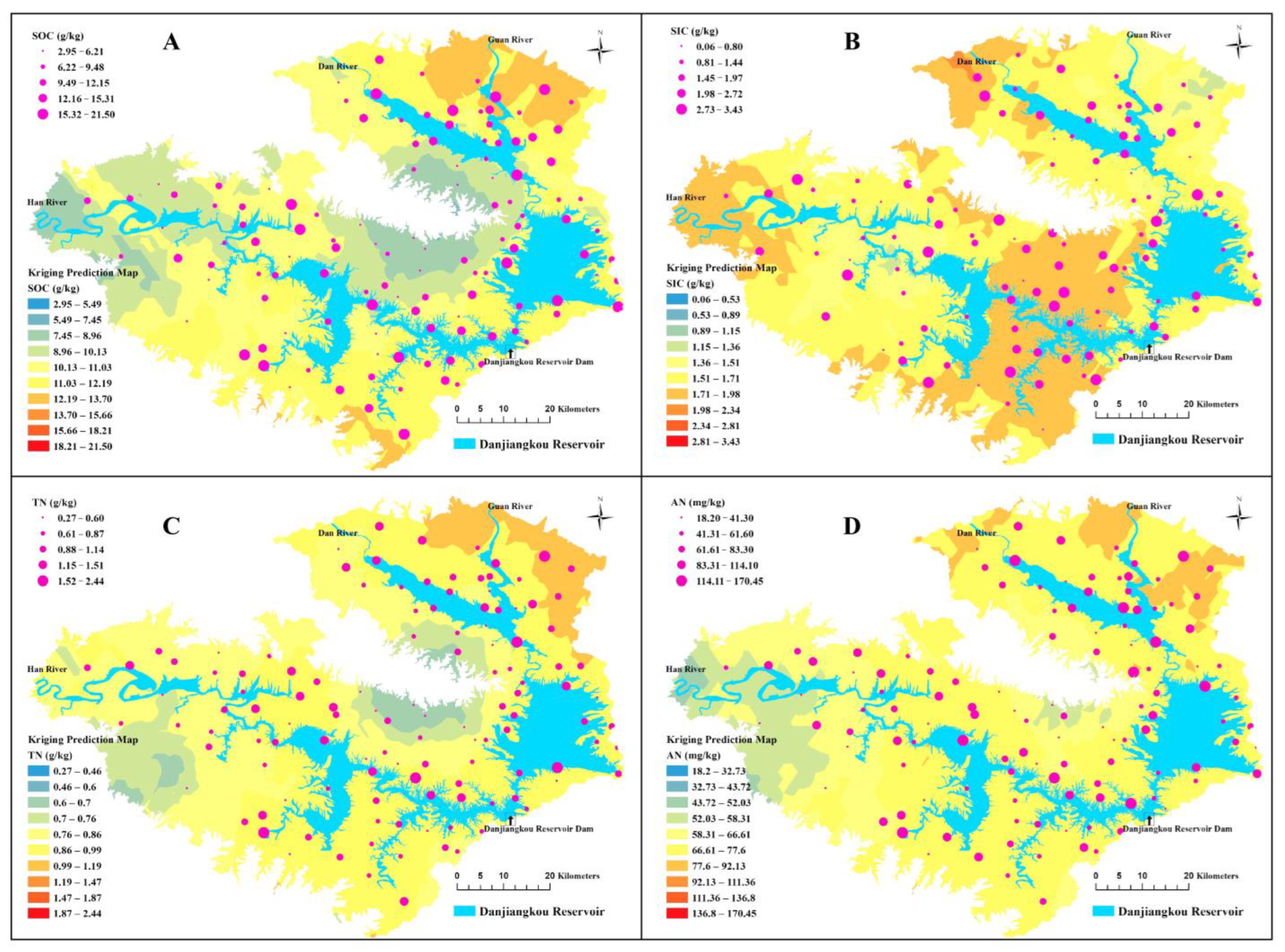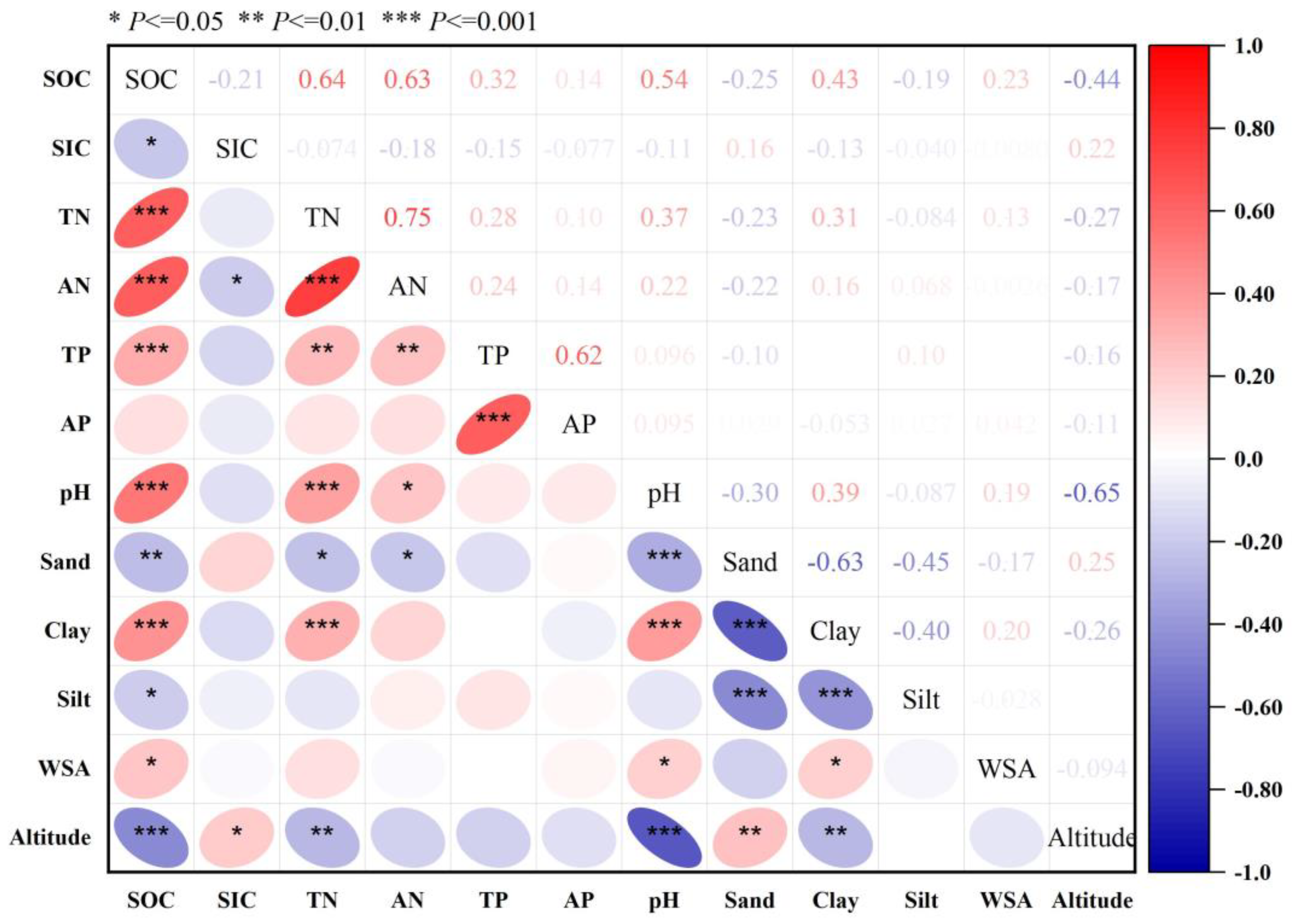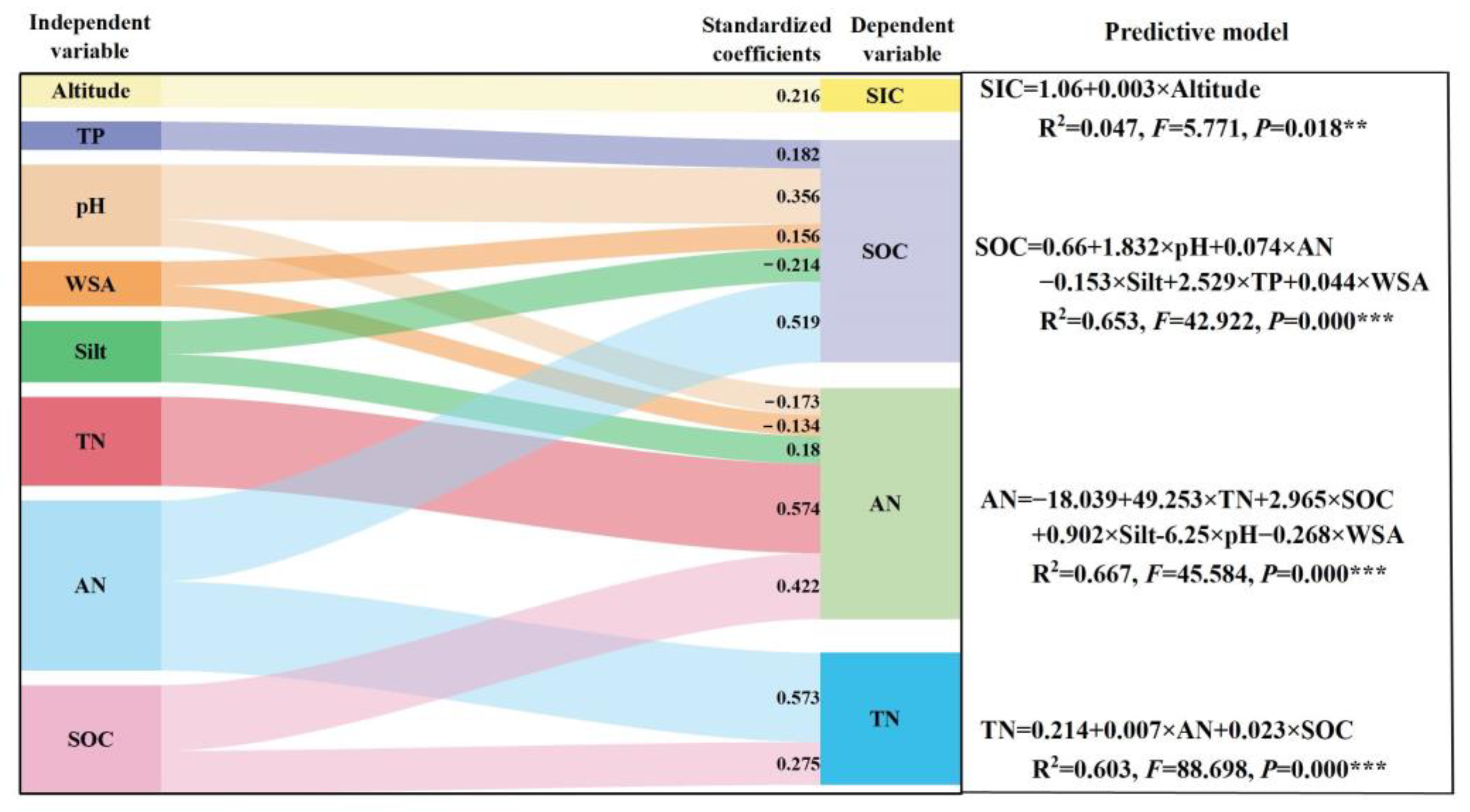Spatial Distribution of Soil Carbon and Nitrogen Content in the Danjiangkou Reservoir Area and Their Responses to Land-Use Types
Abstract
1. Introduction
2. Materials and Methods
2.1. Description of Study Area
2.2. Field Sampling
2.3. Soil Analysis Methods and Classification Standards
2.4. Statistical Analysis
3. Results
3.1. Descriptive and Geostatistical Analysis of Soil C and N Content
3.2. Spatial Distribution Characteristics of Soil C and N Content in the Danjiangkou Reservoir Area
3.3. Differential Characteristics of Soil C and N Content in Different Land-Use Types
3.4. Driving Factors of Spatial Variation in Soil C and N Content
4. Discussion
4.1. Soil C and N Content in the Danjiangkou Reservoir Area
4.2. The Impact of Land-Use Types on Soil C and N Content
4.3. Driving Factors of Spatial Variation in Soil C and N Content
5. Conclusions
Author Contributions
Funding
Institutional Review Board Statement
Informed Consent Statement
Data Availability Statement
Conflicts of Interest
References
- Wang, T.; Kang, F.F.; Cheng, X.Q.; Han, H.R.; Bai, Y.C.; Ma, J.Y. Spatial variability of organic carbon and total nitrogen in the soils of a subalpine forested catchment at Mt. Taiyue, China. Catena 2017, 155, 41–52. [Google Scholar] [CrossRef]
- Wang, J.M.; Yang, R.X.; Bai, Z.K. Spatial variability and sampling optimization of soil organic carbon and total nitrogen for Minesoils of the Loess Plateau using geostatistics. Ecol Eng 2015, 82, 159–164. [Google Scholar] [CrossRef]
- Jalpa, L.; Mylavarapu, R. Current tomato production practices and their effects on plant and soil carbon and nitrogen dynamics. J. Plant Nutr. 2023, 46, 3905–3917. [Google Scholar] [CrossRef]
- Funes, I.; Save, R.; Rovira, P.; Molowny-Horas, R.; Alcaniz, J.M.; Ascaso, E.; Herms, I.; Herrero, C.; Boixadera, J.; Vayreda, J. Agricultural soil organic carbon stocks in the north-eastern Iberian Peninsula: Drivers and spatial variability. Sci Total Environ 2019, 668, 283–294. [Google Scholar] [CrossRef] [PubMed]
- Godoy, V.A.; Zuquette, L.V.; Gomez-Hernandez, J.J. Spatial variability of hydraulic conductivity and solute transport parameters and their spatial correlations to soil properties. Geoderma 2019, 339, 59–69. [Google Scholar] [CrossRef]
- Li, Z.G.; Zhang, R.H.; Liu, C.; Zhang, R.Q.; Chen, F.; Liu, Y. Phosphorus spatial distribution and pollution risk assessment in agricultural soil around the Danjiangkou reservoir, China. Sci. Total Environ. 2020, 699, 134417. [Google Scholar] [CrossRef] [PubMed]
- Sanches, G.M.; Magalhaes, P.S.G.; Franco, H.C.J. Site-specific assessment of spatial and temporal variability of sugarcane yield related to soil attributes. Geoderma 2019, 334, 90–98. [Google Scholar] [CrossRef]
- Zhang, Y.N.; Zhang, G.S.; Pan, J.F.; Fan, Z.H.; Chen, F.; Liu, Y. Soil organic carbon distribution in relation to terrain & land use-a case study in a small watershed of Danjiangkou reservoir area, China. Glob. Ecol. Conserv. 2019, 20, e00731. [Google Scholar] [CrossRef]
- Gao, X.S.; Xiao, Y.; Deng, L.J.; Li, Q.Q.; Wang, C.Q.; Li, B.; Deng, O.P.; Zeng, M. Spatial variability of soil total nitrogen, phosphorus and potassium in Renshou County of Sichuan Basin, China. J. Integr. Agric. 2019, 18, 279–289. [Google Scholar] [CrossRef]
- Fei, Y.H.; She, D.L.; Fang, K. Identifying the Main Factors Contributing to the Spatial Variability of Soil Saline-Sodic Properties in a Reclaimed Coastal Area. Vadose Zone J. 2018, 17, 180118. [Google Scholar] [CrossRef]
- Hu, W.; Shao, M.A.; Wan, L.; Si, B.C. Spatial variability of soil electrical conductivity in a small watershed on the Loess Plateau of China. Geoderma 2014, 230, 212–220. [Google Scholar] [CrossRef]
- Bai, Y.X.; Zhou, Y.C. The main factors controlling spatial variability of soil organic carbon in a small karst watershed, Guizhou Province, China. Geoderma 2020, 357, 113938. [Google Scholar] [CrossRef]
- Wang, H.L.; Wang, J.C.; Wang, J.Y.; Yan, W.D. Insights into the Distribution of Soil Organic Carbon in the Maoershan Mountains, Guangxi Province, China: The Role of Environmental Factors. Sustainability 2023, 15, 8716. [Google Scholar] [CrossRef]
- Yavitt, J.B.; Burtis, J.C.; Smemo, K.A.; Welsch, M. Plot-scale spatial variability of methane, respiration, and net nitrogen mineralization in muck-soil wetlands across a land use gradient. Geoderma 2018, 315, 11–19. [Google Scholar] [CrossRef]
- Paul, O.O.; Sekhon, B.S.; Sharma, S. Spatial variability and simulation of soil organic carbon under different land use systems: Geostatistical approach. Agroforest Syst 2019, 93, 1389–1398. [Google Scholar] [CrossRef]
- Cheng, X.L.; Yang, Y.H.; Li, M.; Dou, X.L.; Zhang, Q.F. The impact of agricultural land use changes on soil organic carbon dynamics in the Danjiangkou Reservoir area of China. Plant Soil 2013, 366, 415–424. [Google Scholar] [CrossRef]
- Liu, Y.; Liu, W.Z.; Wu, L.H.; Liu, C.; Wang, L.; Chen, F.; Li, Z.G. Soil aggregate-associated organic carbon dynamics subjected to different types of land use: Evidence from C-13 natural abundance. Ecol. Eng. 2018, 122, 295–302. [Google Scholar] [CrossRef]
- Zhang, Q.; Zhang, D.D.; Wu, J.J.; Li, J.S.; Feng, J.; Cheng, X.L. Soil nitrogen-hydrolyzing enzyme activity and stoichiometry following a subtropical land use change. Land Degrad. Dev. 2021, 32, 4277–4287. [Google Scholar] [CrossRef]
- Wang, L.; Yuan, X.L.; Liu, C.; Li, Z.G.; Chen, F.; Li, S.Q.; Wu, L.H.; Liu, Y. Soil C and N dynamics and hydrological processes in a maize-wheat rotation field subjected to different tillage and straw management practices. Agric. Ecosyst. Environ. 2019, 285, 106616. [Google Scholar] [CrossRef]
- Wang, H.; Han, Y.P.; Pan, L.D. Spatial-temporal variation of nitrogen and diffusion flux across the water-sediment interface at the hydro-fluctuation belt of Danjiangkou reservoir in China. Water Supply 2020, 20, 1241–1252. [Google Scholar] [CrossRef]
- Liu, W.Z.; Liu, G.H.; Zhang, Q.F. Influence of Vegetation Characteristics on Soil Denitrification in Shoreline Wetlands of the Danjiangkou Reservoir in China. Clean-Soil Air Water 2011, 39, 109–115. [Google Scholar] [CrossRef]
- Wang, M.; Houlton, B.Z.; Wang, S.; Ren, C.; van Grinsven, H.J.M.; Chen, D.; Xu, J.; Gu, B. Human-caused increases in reactive nitrogen burial in sediment of global lakes. Innovation 2021, 2, 100158. [Google Scholar] [CrossRef] [PubMed]
- Sanchez, E.; Zabaleta, R.; Fabani, M.P.; Rodriguez, R.; Mazza, G. Effects of the amendment with almond shell, bio-waste and almond shell-based biochar on the quality of saline-alkali soils. J. Environ. Manag. 2022, 318, 115604. [Google Scholar] [CrossRef] [PubMed]
- Han, F.P.; Zheng, J.Y.; Hu, W.; Du, F.; Zhang, X.C. Spatial variability and distribution of soil nutrients in a catchment of the Loess Plateau in China. Acta Agr Scand B-S P 2010, 60, 48–56. [Google Scholar] [CrossRef]
- Li, Z.; Feng, Q.; Wang, X.; Li, Z.; Wang, Q.J.; Chen, D.; Zhang, B.; Gui, J. Accelerated multiphase water transformation in global mountain regions since 1990. Innov. Geosci. 2023, 1, 100033. [Google Scholar] [CrossRef]
- Song, X.; Du, L.P.; Kou, C.L.; Ma, Y.L. Assessment of Soil Erosion in Water Source Area of the Danjiangkou Reservoir Using USLE and GIS. Lect. Notes Comput. Sci. 2011, 7030, 57–64. [Google Scholar]
- Hu, Y.J.; Zhang, Y.A.; Liu, J.W.; Chen, X.H.; Zhang, J.; Yao, Y.C. Nitrogen-rich animal and plant wastes as fertilizer improve the soil carbon/nitrogen ratio and plant branching and thickening of young walnut trees under deficit irrigation conditions. Arch Agron Soil Sci 2023, 69, 2966–2981. [Google Scholar] [CrossRef]
- Zabaleta, R.; Sánchez, E.; Fabani, P.; Mazza, G.; Rodriguez, R. Almond shell biochar: Characterization and application in soilless cultivation of Eruca sativa. Biomass Convers. Biorefinery 2023. [Google Scholar] [CrossRef]
- Zhang, S.R.; Xia, C.L.; Li, T.; Wu, C.G.; Deng, O.P.; Zhong, Q.M.; Xu, X.X.; Li, Y.; Jia, Y.X. Spatial variability of soil nitrogen in a hilly valley: Multiscale patterns and affecting factors. Sci. Total Environ. 2016, 563, 10–18. [Google Scholar] [CrossRef]
- Deng, Q.; Cheng, X.L.; Yang, Y.H.; Zhang, Q.F.; Luo, Y.Q. Carbon-nitrogen interactions during afforestation in central China. Soil Biol. Biochem. 2014, 69, 119–122. [Google Scholar] [CrossRef]
- Cislaghi, A.; Bordoni, M.; Meisina, C.; Bischetti, G.B. Soil reinforcement provided by the root system of grapevines: Quantification and spatial variability. Ecol. Eng. 2017, 109, 169–185. [Google Scholar] [CrossRef]
- Yang, H.S.; Xu, M.M.; Koide, R.T.; Liu, Q.; Dai, Y.J.; Liu, L.; Bian, X.M. Effects of ditch-buried straw return on water percolation, nitrogen leaching and crop yields in a rice-wheat rotation system. J. Sci. Food Agric. 2016, 96, 1141–1149. [Google Scholar] [CrossRef] [PubMed]
- Huang, B.; Sun, W.X.; Zhao, Y.C.; Zhu, J.; Yang, R.Q.; Zou, Z.; Ding, F.; Su, J.P. Temporal and spatial variability of soil organic matter and total nitrogen in an agricultural ecosystem as affected by farming practices. Geoderma 2007, 139, 336–345. [Google Scholar] [CrossRef]
- Wang, Y.L.; Wu, P.N.; Qiao, Y.B.; Li, Y.M.; Liu, S.M.; Gao, C.K.; Liu, C.S.; Shao, J.; Yu, H.L.; Zhao, Z.H.; et al. The potential for soil C sequestration and N fixation under different planting patterns depends on the carbon and nitrogen content and stability of soil aggregates. Sci. Total Environ. 2023, 897, 165430. [Google Scholar] [CrossRef]
- Neupane, A.; Herndon, E.M.; Whitman, T.; Faiia, A.M.; Jagadamma, S. Manganese effects on plant residue decomposition and carbon distribution in soil fractions depend on soil nitrogen availability. Soil Biol. Biochem. 2023, 178, 108964. [Google Scholar] [CrossRef]
- Li, Q.X.; Feng, J.; Wu, J.J.; Jia, W.; Zhang, Q.; Chen, Q.; Zhang, D.D.; Cheng, X.L. Spatial variation in soil microbial community structure and its relation to plant distribution and local environments following afforestation in central China. Soil Tillage Res. 2019, 193, 8–16. [Google Scholar] [CrossRef]






| Indicator | 1 | 2 | 3 | 4 | 5 | 6 |
|---|---|---|---|---|---|---|
| SOM (g·kg−1) | >40 | 30–40 | 20–30 | 10–20 | 6–10 | <6 |
| SOC (g·kg−1) | >23.2 | 17.4–23.2 | 11.6–17.4 | 5.8–11.6 | 3.5–5.8 | <3.5 |
| TN (g·kg−1) | >2 | 1.5–2 | 1–1.5 | 0.75–1 | 0.5–0.75 | <0.5 |
| AN (mg·kg−1) | >150 | 120–150 | 90–120 | 60–90 | 30–60 | <30 |
| Indicator | Theoretical Model | Nugget C0 | Sill C0+C | Range Km | Proportion C0/(C0+C) | R2 | RSS |
|---|---|---|---|---|---|---|---|
| SOC (g·kg−1) | Exponential | 4.850 | 19.05 | 9.6 | 0.745 | 0.616 | 25.81 |
| SIC (g·kg−1) | Spherical | 0.123 | 0.684 | 6.9 | 0.820 | 0.681 | 0.017 |
| TN (g·kg−1) | Spherical | 0.021 | 0.154 | 6.2 | 0.864 | 0.762 | 0.002 |
| AN (mg·kg−1) | Spherical | 0.000 | 0.224 | 7.1 | 1.000 | 0.757 | 0.009 |
Disclaimer/Publisher’s Note: The statements, opinions and data contained in all publications are solely those of the individual author(s) and contributor(s) and not of MDPI and/or the editor(s). MDPI and/or the editor(s) disclaim responsibility for any injury to people or property resulting from any ideas, methods, instructions or products referred to in the content. |
© 2024 by the authors. Licensee MDPI, Basel, Switzerland. This article is an open access article distributed under the terms and conditions of the Creative Commons Attribution (CC BY) license (https://creativecommons.org/licenses/by/4.0/).
Share and Cite
Xu, B.; Li, Y.; Liu, Y. Spatial Distribution of Soil Carbon and Nitrogen Content in the Danjiangkou Reservoir Area and Their Responses to Land-Use Types. Sustainability 2024, 16, 444. https://doi.org/10.3390/su16010444
Xu B, Li Y, Liu Y. Spatial Distribution of Soil Carbon and Nitrogen Content in the Danjiangkou Reservoir Area and Their Responses to Land-Use Types. Sustainability. 2024; 16(1):444. https://doi.org/10.3390/su16010444
Chicago/Turabian StyleXu, Bo, Yuefen Li, and Yi Liu. 2024. "Spatial Distribution of Soil Carbon and Nitrogen Content in the Danjiangkou Reservoir Area and Their Responses to Land-Use Types" Sustainability 16, no. 1: 444. https://doi.org/10.3390/su16010444
APA StyleXu, B., Li, Y., & Liu, Y. (2024). Spatial Distribution of Soil Carbon and Nitrogen Content in the Danjiangkou Reservoir Area and Their Responses to Land-Use Types. Sustainability, 16(1), 444. https://doi.org/10.3390/su16010444







